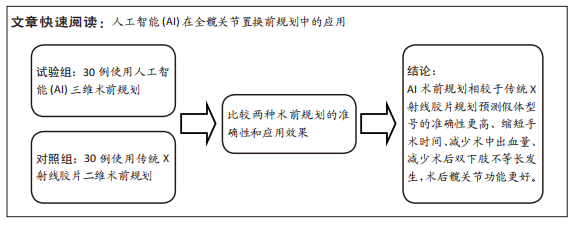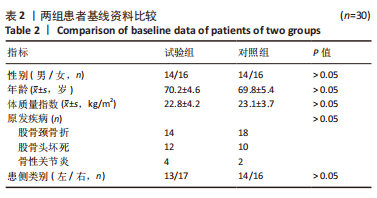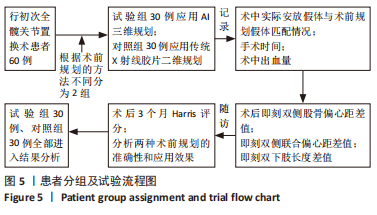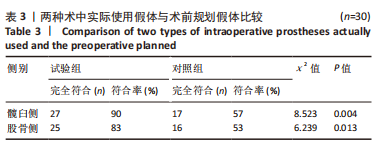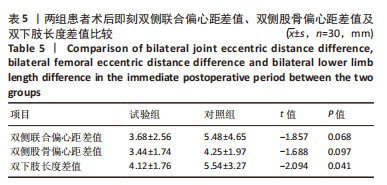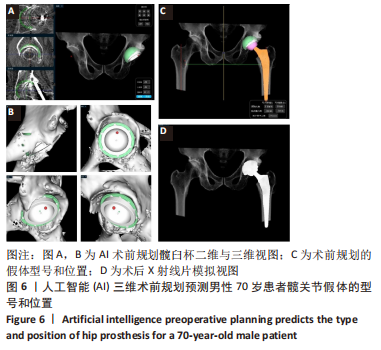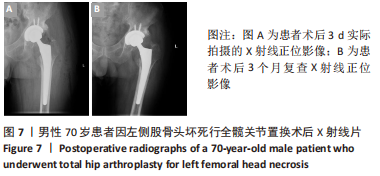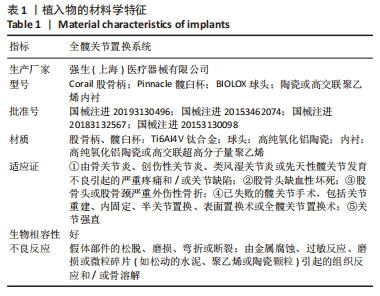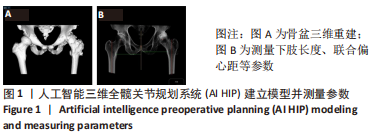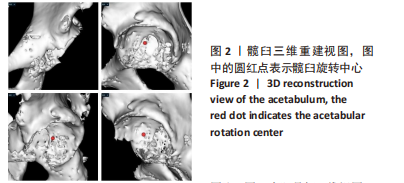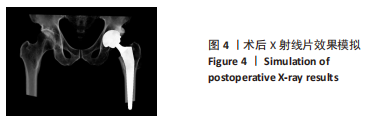[1] 张英泽. 临床创伤骨科流行病学[M].3版. 北京:人民卫生出版社, 2018:703.
[2] ZHANG S, CHEN JY, PANG HN, et al. Development and internal validation of machine learning algorithms to predict patient satisfaction after total hip arthroplasty. Arthroplasty. 2021;3(1):33.
[3] SHAH AA, DEVANA SK, LEE C, et al. Development of a Novel, Potentially Universal Machine Learning Algorithm for Prediction of Complications After Total Hip Arthroplasty. J Arthroplasty. 2021;36(5):1655-1662.e1.
[4] TSENG TW, CHEN YP, YEH YC, et al. Automatic prosthetic-parameter estimation from anteroposterior pelvic radiographs after total hip arthroplasty using deep learning-based keypoint detection. Int J Med Robot. 2022;18(4):e2394.
[5] LAZIC I, HINTERWIMMER F, LANGER S, et al. Prediction of Complications and Surgery Duration in Primary Total Hip Arthroplasty Using Machine Learning: The Necessity of Modified Algorithms and Specific Data. J Clin Med. 2022;11(8):2147.
[6] KARNUTA JM, MURPHY MP, LUU BC, et al. Artificial Intelligence for Automated Implant Identification in Total Hip Arthroplasty: A Multicenter External Validation Study Exceeding Two Million Plain Radiographs. J Arthroplasty. 2022;S0883-5403(22):272-278.
[7] 栗智. AI计算机辅助全髋关节置换术前规划与假体型号选择的研究[D]. 大连:大连医科大学,2021.
[8] MURPHY M, KILLEN C, BURNHAM R, et al. Artificial intelligence accurately identifies total hip arthroplasty implants: a tool for revision surgery. Hip Int. 2022;32(6):766-770.
[9] BORJALI A, CHEN AF, BEDAIR HS, et al. Comparing the performance of a deep convolutional neural network with orthopedic surgeons on the identification of total hip prosthesis design from plain radiographs. Med Phys. 2021;48(5):2327-2336.
[10] KARNUTA JM, HAEBERLE HS, LUU BC, et al. Artificial Intelligence to Identify Arthroplasty Implants From Radiographs of the Hip. J Arthroplasty. 2021;36(7S):S290-S294.e1.
[11] SINGH JA, YU S, CHEN L, et al. Rates of Total Joint Replacement in the United States: Future Projections to 2020–2040 Using the National Inpatient Sample. J Rheumatol. 2019;46(9):1134-1140.
[12] ROUZROKH P, WYLES CC, KURIAN SJ, et al. Deep Learning for Radiographic Measurement of Femoral Component Subsidence Following Total Hip Arthroplasty.Radiol Artif Intell. 2022;4(3):e210206.
[13] WEI J, LI D, SING DC, et al. Can images crowdsourced from the internet be used to train generalizable joint dislocation deep learning algorithms? Skeletal radiology. 2022;51(11):2121-2128.
[14] WEI J, LI D, SING DC, et al. Detecting total hip arthroplasty dislocations using deep learning: clinical and Internet validation. Emerg Radiol. 2022;29(5):801-808.
[15] 方闰, 宁仁德, 吴世桐, 等. 全髋关节置换术后早期Corail股骨柄下沉相关因素分析[J].中国骨与关节损伤杂志,2020,35(6): 595-597.
[16] ROWAN FE, BENJAMIN B, PIETRAK JR, et al. Prevention of Dislocation After Total Hip Arthroplasty. J Arthroplasty. 2018;33(5):1316-1324.
[17] DING X, ZHANG B, LI W, et al. Value of preoperative three-dimensional planning software (AI-HIP) in primary total hip arthroplasty: a retrospective study. J Int Med Res. 2021;49(11): 3000605211058874.
[18] HEVESI M, WYLES CC, ROUZROKH P, et al. Redefining the 3D Topography of the Acetabular Safe Zone: A Multivariable Study Evaluating Prosthetic Hip Stability. J Bone Joint Surg Am. 2022;104(3):239-245.
[19] 徐征宇, 杜俊炜, 姜瑶, 等. 三维数字规划和二维胶片模板测量辅助全髋关节置换的效果比较[J].生物骨科材料与临床研究,2021, 18(2):17-22.
[20] 翁文杰, 王锋, 张海林, 等. 全髋关节置换术后双下肢不等长对功能和满意度影响的研究[C]. 上海:股骨头坏死修复与重建国际研讨会暨辉瑞骨科镇痛高峰论坛论文集,2010:77-79.
[21] IWAKIRI K, OHTA Y, FUJII T, et al. Changes in patient-perceived leg length discrepancy following total hip arthroplasty. Eur J Orthop Surg Traumatol. 2021;31(7):1355-1361.
[22] XIA T, LIU X, LIU J, et al.Artificial intelligence assisted total hip arthroplasty for patients with Crowe type Ⅳ developmental dysplasia of the hip.Zhongguo Xiu Fu Chong Jian Wai Ke Za Zhi. 2021;35(10): 1265-1272.
[23] GALEA VP, INGELSRUD LH, FLORISSI I, et al. Patient-acceptable symptom state for the Oxford Hip Score and Forgotten Joint Score at 3 months, 1 year, and 2 years following total hip arthroplasty: a registry-based study of 597 cases. Acta Orthop. 2020;91(4):372-377.
[24] DAMMERER D, KEILER A, HERRNEGGER S, et al.Accuracy of digital templating of uncemented total hip arthroplasty at a certified arthroplasty center: a retrospective comparative study. Arch Orthop Trauma Surg. 2022;142(10):2471-2480.
[25] HUO J, HUANG G, HAN D, et al. Value of 3D preoperative planning for primary total hip arthroplasty based on artificial intelligence technology. J Orthop Surg Res. 2021;16(1):156.
[26] HOLLIDAY M, STEWARD A. Pre-operative templating for total hip arthroplasty: How does radiographic technique and calibration marker placement affect image magnification? J Med Radiat Sci. 2021;68(3): 228-236.
[27] 丁冉, 王淇, 刘烨,等. 人工智能三维术前规划在全髋关节置换术中的应用和准确性分析[J].生物骨科材料与临床研究,2022,19(2): 33-38.
[28] AMENABAR T, MARIMUTHU K, HAWDON G, et al. Total hip arthroplasty using a short-stem prosthesis: restoration of hip anatomy. J Orthop Surg (Hong Kong). 2015;23(1):90-94.
[29] CHEN X, LIU X, WANG Y, et al. Development and Validation of an Artificial Intelligence Preoperative Planning System for Total Hip Arthroplasty. Front Med (Lausanne). 2022;9:841202.
[30] 吴东, 刘星宇, 张逸凌, 等. 人工智能辅助全髋关节置换术三维规划系统的研发及临床应用研究[J].中国修复重建外科杂志,2020, 34(9):1077-1084. |
